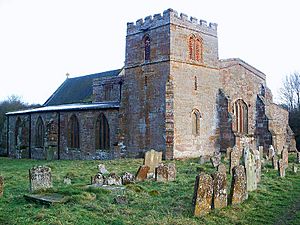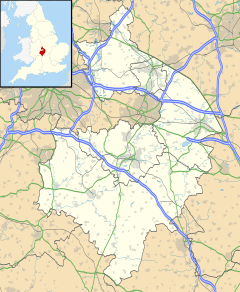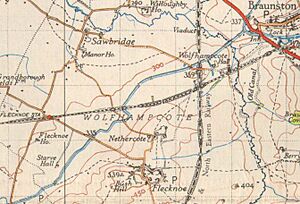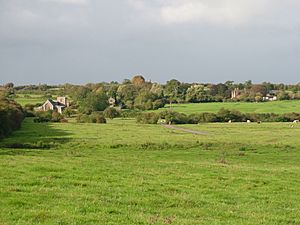Wolfhampcote facts for kids
Quick facts for kids Wolfhampcote |
|
|---|---|
 The Church of St Peter in Wolfhampcote |
|
| Population | 292 (Parish 2021 Census) |
| OS grid reference | SP525655 |
| District |
|
| Shire county | |
| Region | |
| Country | England |
| Sovereign state | United Kingdom |
| Post town | Rugby |
| Postcode district | CV23 |
| Police | Warwickshire |
| Fire | Warwickshire |
| Ambulance | West Midlands |
| EU Parliament | West Midlands |
Wolfhampcote is an interesting place in England. It's known as an abandoned village, which means people used to live there, but they left a long time ago. Today, it's also a civil parish, which is like a local government area. Wolfhampcote is special because it sits right on the border between two English counties: Warwickshire and Northamptonshire.
The eastern edge of the civil parish follows the River Leam. This river also forms the northern border with another civil parish called Willoughby.
Contents
What is the Wolfhampcote Parish?
The civil parish of Wolfhampcote is part of the Rugby borough. It includes the old abandoned village of Wolfhampcote itself. It also covers the nearby village of Flecknoe, which is the biggest settlement in the parish. You'll also find two smaller areas called Sawbridge and Nethercote here.
In 2021, about 292 people lived in the Wolfhampcote parish. This number has grown a little over the years.
Exploring the Old Village
The original village of Wolfhampcote is located west of the A45 road. It's close to Braunston in Northamptonshire. You can get there by following a track from the main A45 road or by a lane from Flecknoe.
The village was first mentioned in a very old book called the Domesday Book. This book was written way back in 1086! Wolfhampcote was called Ufelmscote then. The village was abandoned in the late 1300s, making it a deserted medieval village.
Why Was the Village Abandoned?
There's a local story that the village was wiped out by the Black Death. This terrible plague spread across Europe in the 1300s. The story says that people from London brought the sickness to Wolfhampcote. However, there's no real proof for this legend.
It's more likely that a few families stayed after the plague. They probably found it very hard to keep their farms going. Slowly, these villagers moved away to places with more opportunities. This left the Lord of the Manor (the person who owned the land) to use the empty fields for grazing sheep. An old map from 1637 shows the village as Wulfencote.
What's Left of the Village?
Today, not much remains of the old village. You can still see a cottage, a farmhouse, and the old vicarage (where the church leader lived). The vicarage is a bit further away from the main site.
The most famous building still standing is the Church of St Peter. It looks like it's standing all by itself in a field! The church has been repaired many times. In the 1970s, a group called the Friends of Friendless Churches helped restore it. Now, the Churches Conservation Trust looks after the church. It's only used for services once or twice a year.
Industrial History of the Area
The area around Wolfhampcote has a lot of interesting industrial archaeology. This means you can find old structures from when industries like canals and railways were important.
Canals and Waterways
The Oxford Canal passes north of the old village. This part of the canal was straightened in the 1830s. The original route, built in the 1770s, was much more winding. You can still see parts of that older, twisty path today.
Old Railway Lines
There are also signs of two old railway lines that are no longer used.
- The first was the Weedon to Marton Junction Line. This railway connected Weedon to Leamington Spa, passing through Daventry. It was part of the London and North Western Railway. Passenger trains stopped running in 1958, and freight trains stopped in 1963. This line runs quite close to the south side of the church.
- The second was the Great Central Main Line. This was a major railway route that closed completely in 1966.
These two railway lines actually crossed each other a short distance to the west of the village. It's a fascinating place to imagine how busy it once was with trains and boats!




